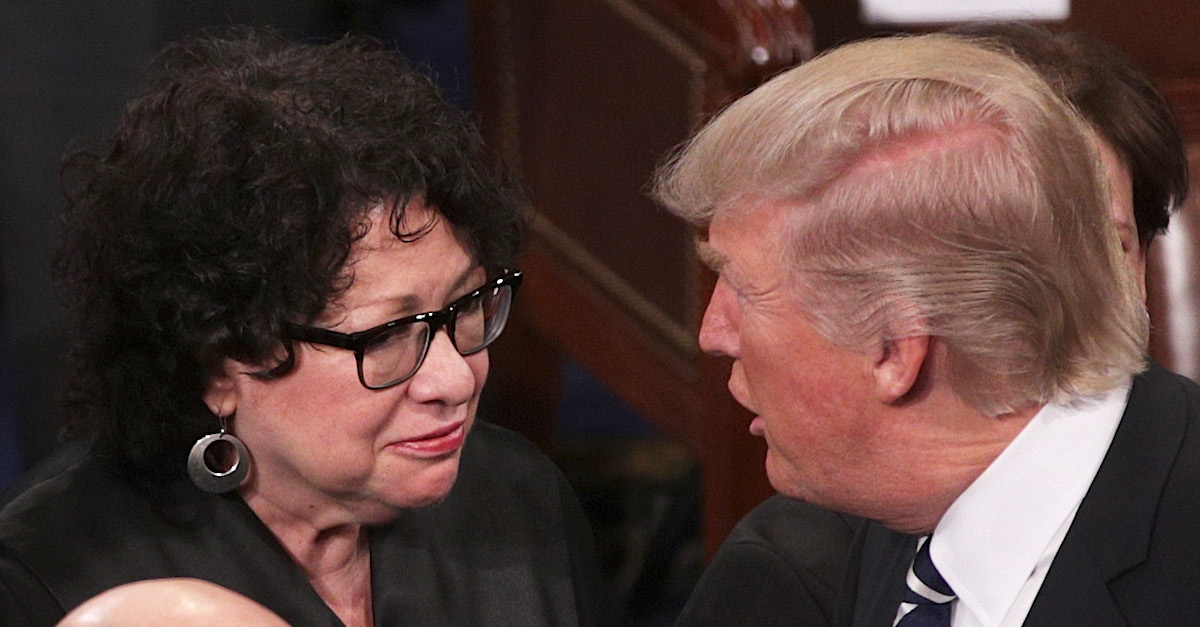
Sotomayor and Trump
Dustin Higgs became the thirteenth and final person executed by the Trump administration Friday night in Terre Haute, Indiana.
As with the twelve others executed, the United States Supreme Court cleared any legal hurdles for Higgs’s execution with a brief, unsigned order. This time, however, that order was accompanied by dissents by both Justice Stephen Breyer and Sonia Sotomayor. Justice Elena Kagan noted that she would have denied the petition (thereby siding with Breyer and Sotomayor), but did not specifically join in either written dissent.
In Breyer’s brief dissent, the justice specifically agreed with Sotomayor’s reasoning, then focused his attention on the specific facts of Higgs’s appeal. Higgs had raised novel issues of law, specifically with regard to whether his COVID-19 diagnosis warranted a delay of execution. “Given the finality and severity of a death sentence, it is particularly important that judges consider and resolve challenges to an inmate’s conviction and sentence,” wrote Breyer. “How just is a legal system that would execute an individual without consideration of a novel or significant legal question that he has raised?” he asked.
Justice Sotomayor began her dissent with a bold roll call of those executed by the federal government:
“Daniel Lee, Wesley Purkey, Dustin Honken, Lezmond Mitchell, Keith Nelson, William LeCroy Jr., Christopher Vialva, Orlando Hall, Brandon Bernard, Alfred Bourgeois, Lisa Montgomery, and, just last night, Corey Johnson. Today, Dustin Higgs will become the thirteenth. To put that in historical context, the Federal Government will have executed more than three times as many people in the last six months than it had in the previous six decades.”
In her dissent, Justice Sotomayor slammed the Department of Justice for its actions since the Trump Administration lifted a previous 17-year moratorium on federal executions. Sotomayor bluntly said, “the DOJ did not tread carefully,” although there was “deep legal uncertainty” due to changes in the drugs used for legal injections. Rather than waiting for courts to appropriately resolve the obvious legal questions, the Trump administration scheduled an “expedited spree of executions.” The Supreme Court’s majority, she wrote, shares the blame, as it ” has consistently rejected inmates’ credible claims for relief.”
Sotomayor continued with a reprimand for the Court’s hasty and unexplained decisions:
“The Court has even intervened to lift stays of execution that lower courts put in place, thereby ensuring those prisoners’ challenges would never receive a meaningful airing. The Court made these weighty decisions in response to emergency applications, with little opportunity for proper brief- ing and consideration, often in just a few short days or even hours. Very few of these decisions offered any public explanation for their rationale.”
“This is not justice,” Sotomayor snapped. “After waiting almost two decades to resume federal executions, the Government should have proceeded with some measure of restraint to ensure it did so lawfully. When it did not, this Court should have. It has not,” she continued.
The justice next turned to the specific facts of the Higgs case. Both Dustin Higgs and Corey Johnson tested positive for COVID-19 on December 16, 2020. Both argued that lung damage caused by the virus increased the chances that they’d suffer illegal levels of pain if executed with pentobarbital. Sotomayor explained in her dissent that “despite the District Court’s careful fact-finding and the risk of needless and significant pain,” the appellate court reversed the lower court’s order to stay their executions. The Supreme Court did nothing to overturn that decision. Johnson was executed Thursday night, and Higgs the next.
Justice Sotomayor also raised the case of Brandon Bernard. Bernard was executed December 10, 2020, for crimes he committed when he was eighteen. Bernard’s appeals raised credible allegations that prosecutors knowingly used false testimony against him and illegally withheld exculpatory evidence. When he was sentenced, Bernard was the youngest person to ever receive a federal death sentence.
Sotomayor dissented to the Court’s ruling in the Bernard case, saying that the majority’s unsigned ruling “perversely rewards the Government for keeping exculpatory information secret.” In the Higgs dissent, Sotomayor said that the Court left this “dangerous precedent in place and, again, condoning the Government’s tactics.”
The recent executions of Wesley Purkey and Lisa Montgomery were also noted by the justice as examples of the high court’s poor judgment. Both cases involved inmates with minimal cognitive ability. Purkey suffered from Alzheimer’s disease, and Montgomery had been in a dissociative psychotic state. Therefore, there are significant legal questions as to the Constitutionality of their executions. However, wrote Sotomayor, “We will never have definitive answers to those questions because this Court sanctioned their executions anyway.”
Dustin Higgs, along with the other twelve inmates executed by the DOJ, “deserved more from this Court,” concluded the justice.
Justice Sonia Sotomayor’s dissent tonight in U.S. v. Dustin Higgs will be remembered long into the future as one of the most thorough, resounding indictments of this administration’s reckless, immoral, illegal effort to execute as many people as possible, as quickly as possible.
— Sister Helen Prejean (@helenprejean) January 16, 2021
[image via Alex Wong/Getty Images]
Have a tip we should know? [email protected]